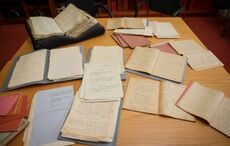The bodies of 57 Irish immigrants who were left for dead in an unmarked mass grave outside Philadelphia may finally be buried in Ireland.
“We hope to find every piece of these men's history, recover it and return them home," said Lutheran pastor Frank Watson working on the mass grave known as Duffy's Cut.
Watson has been working with his brother William and a team of archeologists at Duffy's Cut in Malvern, PA, to try and discover what happened to the men in 1832.
- Video / Christy Moore sings 'Duffy's Cut' / Click here
- Video / Irish Ambassador visits 'Duffy's Cut' / Click here
The Watsons first found the remains of a man they believe to be John Ruddy in March. And just last week, they found the remains of two more bodies at the site, and the findings are ominous.
"We can tell they dumped the bodies," said Watson, "the men were buried hastily, their bodies weren't treated with respect."
“We found the men buried, but oriented different in the grave. A typical burial has the head facing west and the feet facing east, the other body was the head facing east and the body facing west. From this we can tell they dumped the bodies."
They fled Ireland on board the John Stamp ship from Derry in April 1832 to seek work building the railways in Philadelphia.
Working on the railroads was backbreaking toil in 1832. There was no heavy machinery to lift the steel rails, the wooden sleepers or the ballast bed underneath the tracks. The workers had to lay every foot of track by hand.
And the railroads had to be built quickly. America was in a hurry to expand, so the railroads imported shiploads of cheap labor from Ireland where men were desperate to work at anything. And work they did, from dawn to dusk, in boiling sun or freezing snow.
The John Stamp passengers, who were hired by an Irish contractor called Philip Duffy, never made it to the work force.
Now, Watson, along with with his brother Dr. Bill Watson and their team of archeologists and historians, hope to finally discover what happened to the men.
Was it cholera? Or were the men murdered near mile 59, which would later come to be known as Duffy's Cut?
Cholera was much feared in the 19th century as it spread like wildfire among the slums and tenements of the immigrant workforce.
But one thing is certain, they were left to die on their own.
During the summer of 1832, almost 1,000 people died in Philadelphia from cholera, which in those days had a death rate of about 30 per cent.
The Watsons have been carrying out their real-life detective work since 2000 when they inherited a package of papers from their grandfather who worked on the railroad. The papers told how the railroad censored all information about the deaths.
Although it remains to be seen whether they can establish the cause of death.




Comments